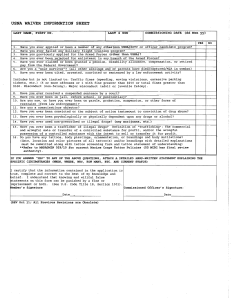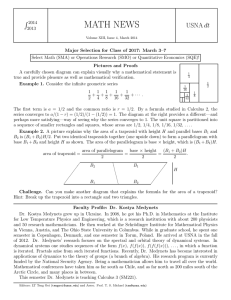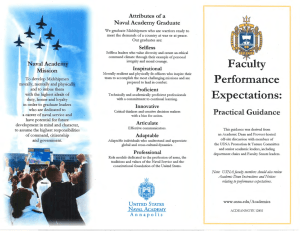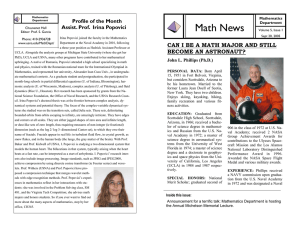The Math News
advertisement
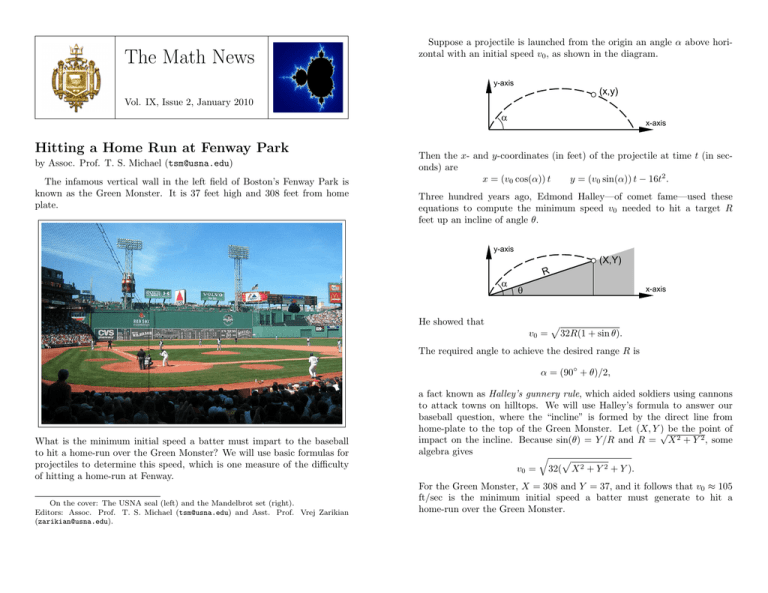
The Math News Suppose a projectile is launched from the origin an angle α above horizontal with an initial speed v0 , as shown in the diagram. y-axis (x,y) Vol. IX, Issue 2, January 2010 α Hitting a Home Run at Fenway Park by Assoc. Prof. T. S. Michael (tsm@usna.edu) The infamous vertical wall in the left field of Boston’s Fenway Park is known as the Green Monster. It is 37 feet high and 308 feet from home plate. x-axis Then the x- and y-coordinates (in feet) of the projectile at time t (in seconds) are x = (v0 cos(α)) t y = (v0 sin(α)) t − 16t2 . Three hundred years ago, Edmond Halley—of comet fame—used these equations to compute the minimum speed v0 needed to hit a target R feet up an incline of angle θ. y-axis (X,Y) α R θ x-axis He showed that v0 = p 32R(1 + sin θ). The required angle to achieve the desired range R is α = (90◦ + θ)/2, What is the minimum initial speed a batter must impart to the baseball to hit a home-run over the Green Monster? We will use basic formulas for projectiles to determine this speed, which is one measure of the difficulty of hitting a home-run at Fenway. On the cover: The USNA seal (left) and the Mandelbrot set (right). Editors: Assoc. Prof. T. S. Michael (tsm@usna.edu) and Asst. Prof. Vrej Zarikian (zarikian@usna.edu). a fact known as Halley’s gunnery rule, which aided soldiers using cannons to attack towns on hilltops. We will use Halley’s formula to answer our baseball question, where the “incline” is formed by the direct line from home-plate to the top of the Green Monster. Let (X, Y √ ) be the point of impact on the incline. Because sin(θ) = Y /R and R = X 2 + Y 2 , some algebra gives q p v0 = 32( X 2 + Y 2 + Y ). For the Green Monster, X = 308 and Y = 37, and it follows that v0 ≈ 105 ft/sec is the minimum initial speed a batter must generate to hit a home-run over the Green Monster. The late Prof. Howard Penn of the USNA Math Department performed a similar analysis to compute the average minimum initial speed needed to a hit a home-run in each major league ball-park (taking into account the varying heights and distances for left-, center-, and right-fields). The average minimum speed falls in the range 100–110 ft/sec for each ballpark. Midshipmen study projectile motion in SM122 (Calculus II) and SM221/223 (Calculus III). Coming Attraction: Soap Bubbles & Math In Memory: Prof. Howard Penn (1946-2009) Professor Howard Penn, Math Department, died a longtime member of the USNA unexpectedly on 23 November 2009. He will be missed by his colleagues and students alike. Prof. Penn was born in Bayonne, NJ, on 9 November 1946. He grew up in Louisville, KY, graduating from Atherton High School in 1964. He received his B.S. in Math from Indiana University in 1968 and went on to graduate school at the University of Michigan. He completed his Ph.D. in 1973 under the direction of Professor Allen Shields, in the area of complex function theory, and the title of his dissertation was On H p Spaces of a Semigroup. That same year, Prof. Penn began his distinguished career at USNA. Some highlights include: • Publishing scholarly articles in the Rocky Mountain Journal of Mathematics, the Pacific Journal of Mathematics, and the College Mathematics Journal. • Attaining the rank of Full Professor in 1987. • Receiving the Mathematics Association of America Certificate for Meritorious Service in 1995. Who: Professor Frank Morgan (Williams College), an expert on minimal surfaces, former VP of the Mathematical Association of America, current VP of the American Mathematical Society. What: The first annual Julian Clancy Frazier Mathematics Colloquium. When: Wednesday, 27 January 2010, from 1915-2015 Where: Mitscher Auditorium Why: To hear an informative and entertaining presentation on “Soap Bubbles and Mathematics”. Because there will be live demonstrations, a contest with prizes, and free food. For extra credit? How: This event is made possible by a generous gift from Ms. Jean S. Clancy to the USNA Math Department in the memory of her son, Julian Clancy Frazier. • Being awarded the Navy Meritorious Civilian Service Award in 2002. Prof. Penn’s personal interests included photography (he was a member and president of the Arundel Camera Club), wildlife (he was a docent at the Maryland Zoo in Baltimore), and softball (he pitched for the Math Department team in the USNA Officer-Faculty Softball League). Large collections of Prof. Penn’s photographs may be viewed online at http://www.angelfire.com/md3/pennphoto/Home.htm and http://www.flickr.com/photos/howardpennphoto/ Prof. Penn, who lived in Arnold, MD, is survived by his wife Beth (they were married in 1968) and their daughter Rachel (born in 1977).


